Why bitter orange is useful and how is it used
Orange, bitter orange, chinotto, bigaradia, Chinese apple - all these are the names of the fruits of the evergreen citrus plant. The rich chemical composition, rich taste and aroma, the abundance of essential oils in the leaves, unripe fruits, peel and flowers, low energy value allow the widespread use of orange in cooking, folk medicine, aromatherapy, cosmetology and dietetics.
The content of the article
Description
Pomeranian (lat.Citrus aurantium) is an evergreen tree from the genus Citrus, family Rute... According to geneticists, this is a hybrid of mandarin and pomelo, the closest relative of lemon.
In natural form, fruits are rarely consumed due to the abundance of essential oils and a very specific taste.
Other names for the fruit:
- sour or bitter orange;
- bigarady;
- chinotto;
- bigarade;
- Chinese apple;
- Seville orange.
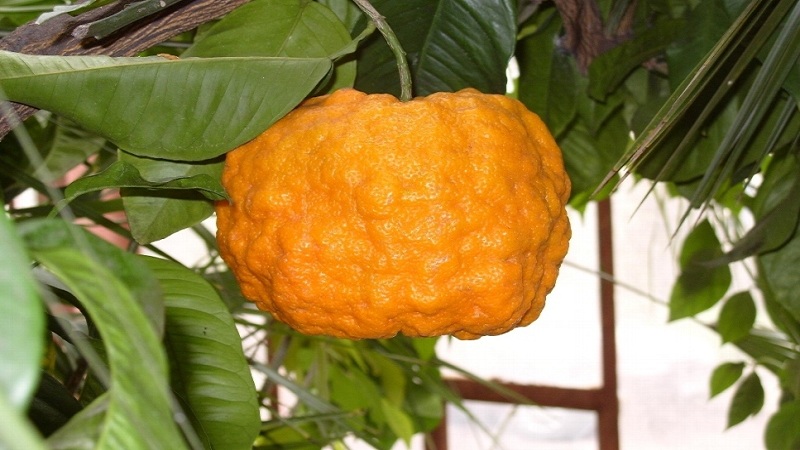
A tree 2-10 m high with long thorny branches... Leaves are petiolate, alternate, leathery, glossy. The front side is green, the back is light green with essential oil storage. Petioles are long, broad-leaved, sharply tapering towards the base.
The flowers are large (2-3 cm in diameter), located singly or in the axils of 2-7 pieces, exude a fragrant aroma. The pubescent calyx is four- and five-toothed. The corolla consists of 4-8 white oblong fleshy petals that contain essential oil.
Reference! The plant blooms in April - May, bears fruit in November - January.
Berry-shaped fruits, in the form of a ball, sometimes flattened from the poles... Diameter - 6-7 cm. The peel is thick, bumpy, bright orange, easily separated from the pulp, contains essential oil. The pulp consists of 10-12 slices, sour with bitterness.
Light yellow flattened-wedge-shaped seeds with furrows... Ovaries are dark green in color, formed on the 3rd day of flowering.
Interesting! Bitter orange flowers are called orange blossom. They were used to create wedding decorations for the bride as a symbol of innocence, woven into wreaths and bouquets.
Origin and distribution
Homeland of culture - Southeast Asia... From there, the plant spread to the Middle East, to India through Persia. The culture was brought to Europe, namely to Spain, by Arab merchants.
The orange is grown in countries located on the Mediterranean coast, in Paraguay, in the Caucasus, the islands of the West Indies, India, Abkhazia, in the Caribbean. Bitter orange is not found in the wild.
In European countries, the crop is harvested once a year.: in October - December. At the same time, flowering begins in April. In the tropics, the orange bears fruit 2 times a year, before the rainy season.
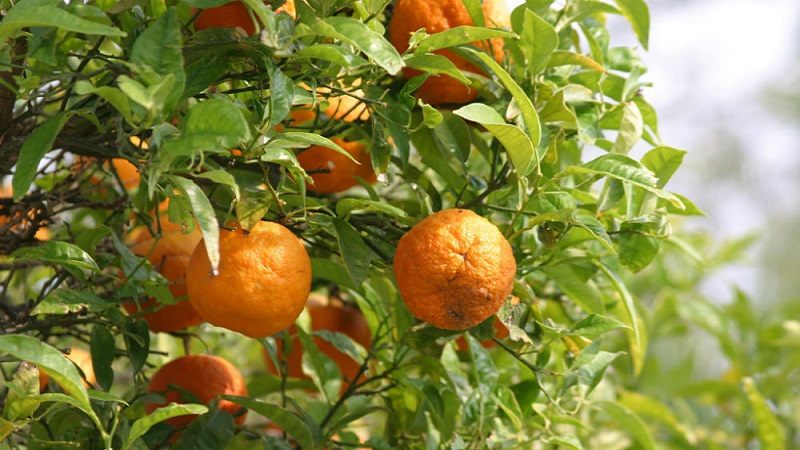
Composition and properties
Bitter orange fruits contain:
- citric, malic, salicylic, gallic acids;
- pectins;
- aldehydes;
- glycosides hesperidin and isoesperidin;
- tannins and bitterness.
Unripe fruits, leaves and stems contain petitgrain orange oil, which contains β-pinene, nerol, camphene, geraniol, D-α-terpineol, limonene, dipentene, L-linalool, sesquiterpenes.
Reference! Orange peel oil has a lemon scent, and the composition and properties are similar to orange oil.
The essential oil from flowers is called neroli.... It has a delicate pleasant aroma, contains geraniol and linalool, limonene, camphene, nerol and other terpenes, acetic and benzoic acids.Possesses soothing properties, stimulates cell growth.
To obtain essential oil from unripe fruits and flowers, 2 methods are used:
- distillation with steam;
- enflerage - fat oil extraction.
Essential oil from the peel of ripe fruits (orange, or orange bitter) is extracted by pressing without preliminary heating.
Leaf oil called petitgrain, of flowers - neroli.
Interesting on the site:
KBZHU
The energy value of the product is low. The main food is zest.
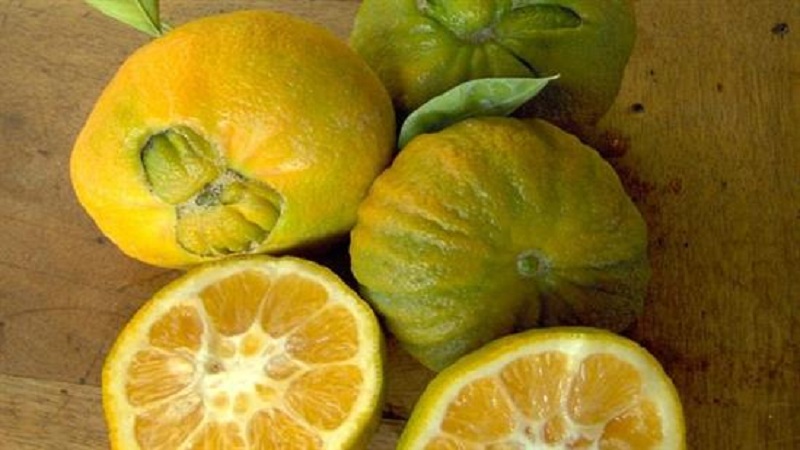
Nutritional value of 100 g of product:
- calorie content - 53 kcal;
- proteins - 0.81 g;
- fats - 0.31 g;
- carbohydrates - 11.54 g;
- water - 82.5 g;
- ash - 0.5 g.
Benefit
Useful properties of orange:
- diaphoretic and anti-inflammatory;
- antiseptic and bactericidal;
- analgesic and antispasmodic;
- anticoagulant;
- bile and diuretic;
- tonic;
- laxative, carminative and antiemetic;
- antitussive and expectorant;
- immunostimulating;
- regenerating;
- anti-sclerotic.
Orange relieves nervous tension, reduces irritability, normalizes sleep, improves memory and attention... Tincture from the peel of ripe fruits stimulates appetite, improves digestion. Orange oil strengthens the cardiovascular and endocrine systems.
Due to the high content of essential oils, the plant is contraindicated. pregnant women and children.
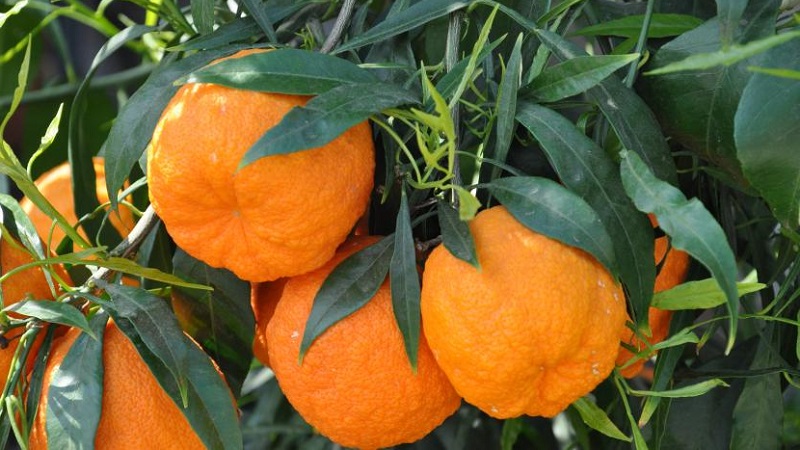
Application
Essential oil, extract, orange peel are widely used in cooking, folk medicine, aromatherapy, cosmetology, dietetics.
In cooking
Bitter orange fruits are used in many cuisines around the world. Of them prepare candied fruits, marmalade, refreshing and alcoholic, drinks, ice cream, salads, jams, decorations for desserts and cakes... The grated zest gives curd, butter and yoghurt creams an intense yellow tint and a pleasant aroma.
Important! Fresh fruits are inedible.
Best of all, the taste of orange is revealed in hot dishes.... It is put in sauces, marinades for red meat and poultry. To maintain a fresh orange flavor, juice and zest are added at the end of cooking.
Orange bitter is prepared on the basis of orange - an alcoholic drink with a peculiar bitter taste. It is often added to cocktails. The bitter is expensive, but it is also prepared at home.
For a classic recipe you will need:
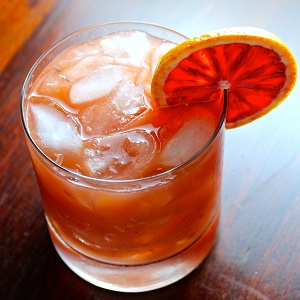 500 ml of vodka;
500 ml of vodka;- 50 g dried and 100 g fresh bitter orange zest;
- 1/2 tsp cardamom;
- 1/3 anise stars;
- 2 tbsp. l. brown sugar;
- 1/2 tbsp. l. dried gentian root;
- 1/2 tbsp. l. tinctures of Potentilla roots and angelica (as bitterness).
Preparation:
- All components, except sugar and tincture, are crushed and poured with vodka.
- The container is stored in a dark place for 2 weeks, shaking occasionally. The alcohol level is constantly monitored as the zest actively absorbs liquid. If necessary, add vodka and shake the contents.
- After 2 weeks, tasting is carried out. If the taste of orange is weak, the liquor is left for another week or a portion of the zest is added.
- At the end of cooking, the liqueur is filtered.
- Brown sugar is poured over 50 ml of water and put on low heat. As soon as the mass acquires a caramel shade, the container is removed from the heat and cooled slightly. Then it is gradually introduced into the liquor, the container is closed and shaken.
- The drink is insisted for 4-5 days, bitterness is added, tasting the alcohol.
The main thing is not to add too much tinctureotherwise the finished product will be too bitter. The strength of the liqueur should be 30%.
Read also:
What is mandarin: where is it from, how and where it grows
In folk medicine
Traditional medicine uses bitter orange oil, zest, seeds and flowers:
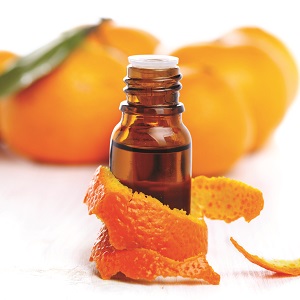 High efficiency is observed when using essential oil in the treatment of infected wounds.
High efficiency is observed when using essential oil in the treatment of infected wounds.- The fruits are used as a carminative and laxative.
- The seeds are used for coughs, chest pains and colds.
- The zest strengthens the heart muscle: the dried peel is ground into flour and taken 10 g per day with water.
- Orange has lymphatic drainage properties and prevents the development of atherosclerosis.
- Spasmolytic properties relieve migraines, headaches, muscle cramps. To treat headaches, a peel-based ointment is used: it is ground and mixed with apple cider vinegar until a thick paste is obtained. The agent is applied to the temporal region and left for 20 minutes, then washed off.
- Bitter orange juice, mixed with water in a 1: 1 ratio, gargle with sore throat and laryngitis.
- The tampons soaked in juice stop nosebleeds.
- The oil helps to get rid of hyperhidrosis and dermatitis.
- Fruit juice eliminates hangover syndrome due to its antitoxic properties.
- To reduce pain in the joints, use the following infusion: 20 g of lemon balm, 10 g of St. John's wort, 10 g of orange flowers, 5 g of rose hips. At 1 st. l. collection, take 100 ml of boiling water and leave for 15 minutes. The tool is taken three times a day, 100 ml.
- On the basis of this collection, an alcoholic infusion is prepared for rubbing ligaments and joints. Crushed raw materials are poured into 450-500 ml of vodka and insisted in a dark place for 14 days. Then filter, squeeze herbs.
- To normalize sleep, use a herbal mixture: 10 g of valerian root, 10 g of hops, 10 g of lemon balm, 10 g of bitter orange flowers. At 1 st. add boiling water 2 tsp. fragrant collection, insist for 10 minutes and take 100 ml in the evening.
In Arab countries, orange is used as an antidepressant thanks to its tonic and soothing properties. The oil reduces nervous excitability, eliminates attacks of anxiety and neurasthenia.

In cosmetology
In cosmetology, bigarady used for the preparation of deodorant agents, creams, lotions, masks, balms and shampoos for hair, perfume.
Hair products eliminate scalp itching, dandruff, strengthen hair follicles, restore hair after bleaching, perm, prolonged exposure to ultraviolet radiation.
Essential oil and dry extract of orange have strong anti-cellulite properties... The funds accelerate blood microcirculation and metabolism in problem areas, reduce volumes by removing excess fluid from tissues, and tighten the skin.
Bitter orange effectively fights acne, tightens pores, eliminates blackheads by regulating sebum secretion.
Interesting! The fashion for neroli was introduced by Anna Maria Orsini, Princess of Neroli. In those days, oil was endowed with magical properties and was considered the strongest aphrodisiac. On its basis, love spells and potions were prepared for women trying to get pregnant to no avail.
The oil is used for rejuvenation and nutrition of dry skin of the face and body.
In aromatherapy
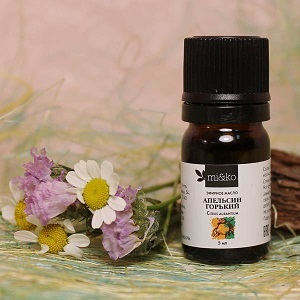 The properties of the essential oil of orange are used in aromatherapy to tone the body, eliminating depression, increasing sensuality, creating a romantic flair. In ancient times, it was considered "a balm for a wounded heart", helping to cope with the blows of fate.
The properties of the essential oil of orange are used in aromatherapy to tone the body, eliminating depression, increasing sensuality, creating a romantic flair. In ancient times, it was considered "a balm for a wounded heart", helping to cope with the blows of fate.
Orange baths and inhalation relieve chronic fatigue, depression, insomnia, nightmares. The oil warms, increases potency, sexual energy, awakens intuition.
For use in aroma lamps, the area of the room is taken as a basis: 15-20 m2 5-6 drops are enough. Add 1-3 drops to aroma medallions.
Add 4-5 drops of oil to the hot bathpre-mixed with milk. It does not dissolve in water and remains in the form of a film on the body, causing a burning sensation. Milk acts as an emulsifier.
Interesting! The scent of orange is a symbol of energy, striving for the top, leadership, glory and nobility.
In losing weight
Bitter orange contains a substance called synephrine, which stimulates metabolism, accelerating the frequency of contraction of the heart muscle, increasing pressure. Thanks to these properties, orange is added to weight loss preparations. At the same time, the evidence base for the effectiveness of such drugs has not yet been presented. Their use is recognized as unsafe due to side effects: tachycardia, arrhythmias, chest pain, shortness of breath.
There is no mono-diet based on orange, since it is not consumed in its natural form... Zest and freshly squeezed juice are added to fruit drinks, water or tea. Weight loss occurs due to a pronounced diuretic effect, but only excess water leaves the body, this does not affect the breakdown of fats.
Bitter orange extract application
In addition to essential oil, orange extract is used in pharmaceuticals... It reduces appetite, stimulates heat exchange, and mobilizes lipid metabolism.
 The pharmacies sell tablets, capsules with an extract that is extracted from the peel by the extraction method. They belong to dietary supplements with unproven efficacy, however manufacturers claim that such funds:
The pharmacies sell tablets, capsules with an extract that is extracted from the peel by the extraction method. They belong to dietary supplements with unproven efficacy, however manufacturers claim that such funds:
- normalize the work of the heart;
- prevent thrombosis;
- improve venous circulation;
- improve the condition of the facial skin;
- restore vital energy;
- normalize sleep.
Harm and contraindications
Bigarady is not recommended to use:
- for allergies to citrus fruits or individual intolerance;
- during pregnancy and breastfeeding;
- children under 3 years old;
- with gastritis, pancreatitis and stomach ulcers.
Bitter orange juice negatively affects tooth enamel, so it is diluted with water or tea in a 1: 2 ratio.
Preparations with orange extract are recommended to be washed down with clean water, avoid combining with coffee and other medicines that accelerate the heart rate.
In case of an overdose, headache, nervous tension and tachycardia.
Conclusion
Bitter orange, or orange, is little known in our area, but it is actively grown in the Mediterranean countries, Southeast Asia, India, Abkhazia, and the Caribbean islands. Essential oils, organic acids, glycosides and pectins have antibacterial, anti-inflammatory, immunomodulatory and diaphoretic effects.
Orange is used in the treatment of acute respiratory viral infections, laryngitis and tonsillitis, for the prevention of thrombosis, memory improvement, regulation of the digestive tract, and increased appetite. Essential oils (neroli, petitgrain) are added to anti-cellulite cream, hair and skin products, aroma lamps to improve the psycho-emotional state.